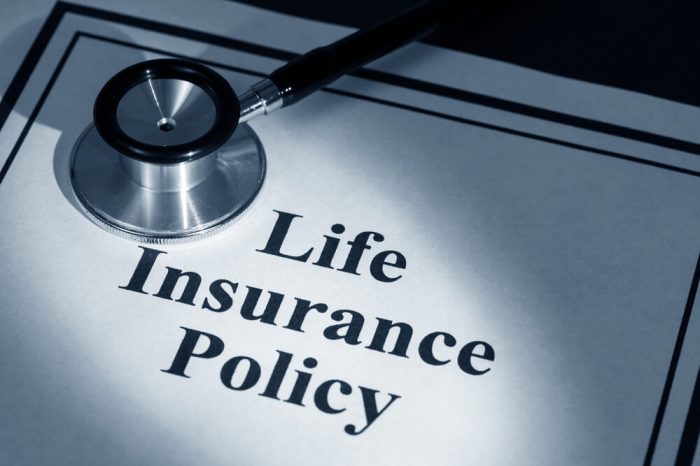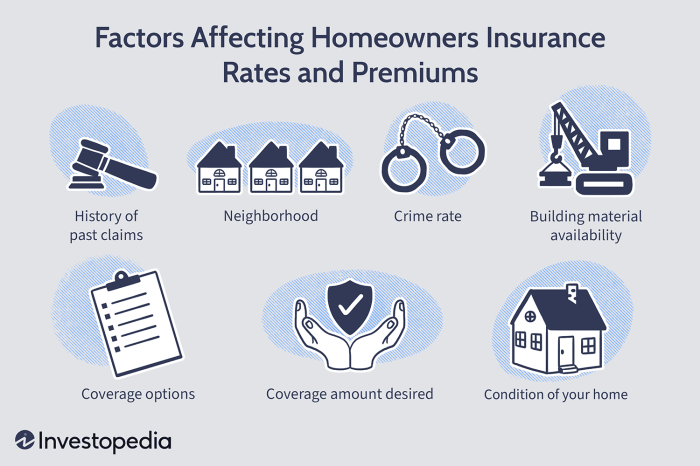Securing life insurance is a crucial step in financial planning, offering peace of mind for your loved ones. However, the cost of this protection—the premium—can vary significantly. Understanding the factors that influence life insurance premiums is essential for making informed decisions and finding the best policy for your individual needs. This guide delves into the key elements that determine how much you’ll pay, empowering you to navigate the complexities of life insurance with confidence.
From your age and health status to the type of policy you choose and even your credit history, numerous factors contribute to the final premium. We’ll explore each of these influences in detail, providing clear explanations and practical examples to help you understand the pricing structure and make the most suitable choice for your circumstances. By the end, you’ll be equipped to confidently compare policies and select the life insurance coverage that best aligns with your budget and long-term goals.
Age

Age is a primary factor influencing life insurance premiums. Insurers assess risk based on statistical probabilities of mortality, and as age increases, the likelihood of death within the policy term rises significantly. This increased risk translates directly into higher premiums for older applicants.
Life insurance companies utilize sophisticated actuarial models that consider vast amounts of demographic and mortality data to calculate the probability of a policyholder passing away during the policy’s duration. These models demonstrate a clear and consistent correlation between age and the likelihood of a claim.
Age and Premium Rates
The table below illustrates the relationship between age and average life insurance premiums. Note that these are average figures and actual premiums will vary based on several other factors, including health, lifestyle, and the type of policy chosen. These figures are illustrative and based on hypothetical data for simplicity. Real-world premium calculations are far more complex.
| Age Range | Average Premium (Male) | Average Premium (Female) | Premium Difference Percentage |
|---|---|---|---|
| 25-34 | $25 | $20 | 25% |
| 35-44 | $40 | $35 | 14% |
| 45-54 | $75 | $65 | 15% |
| 55-64 | $150 | $130 | 15% |
Reasons for Higher Premiums in Older Applicants
Several factors contribute to the higher premiums charged to older applicants. The most significant is the increased probability of death. As individuals age, the risk of developing serious health conditions increases, leading to a higher likelihood of a claim being filed by the insurer. This increased risk necessitates higher premiums to maintain the financial stability of the insurance company. Additionally, older individuals generally have a shorter life expectancy, meaning the insurance company has a shorter period to collect premiums before potentially paying out a death benefit. This shorter timeframe impacts the profitability of the policy for the insurer, contributing to higher premium costs. Furthermore, the accumulation of health issues and potential pre-existing conditions also play a significant role in premium determination. A history of health problems can result in higher premiums, reflecting the elevated risk associated with those conditions.
Health Status

Your health status is a major factor influencing your life insurance premiums. Insurers assess your risk of needing to pay out a claim, and pre-existing conditions or lifestyle choices significantly impact this assessment. A healthier individual generally represents a lower risk, resulting in lower premiums.
Your medical history plays a crucial role in determining your life insurance premium. Insurers review your medical records to identify any potential health concerns that could increase your risk of death within the policy’s coverage period. The more extensive and severe your medical history, the higher your premium is likely to be. This is because the insurer is taking on a greater financial risk by insuring you.
Medical History’s Influence on Premiums
The impact of medical history on premiums varies depending on the severity and type of condition. For example, a history of heart disease or cancer will typically lead to significantly higher premiums than a history of minor allergies. Insurers use sophisticated actuarial models to analyze the statistical probability of a claim based on various health factors. This analysis allows them to accurately price policies to reflect the level of risk. The severity and recency of medical events are also carefully considered; a recent heart attack will carry a heavier weight than one that occurred many years ago and was successfully treated.
Common Health Conditions Affecting Life Insurance Costs
Several health conditions commonly lead to increased life insurance premiums. These include cardiovascular disease (including heart attacks, strokes, and high blood pressure), cancer (various types), diabetes, kidney disease, and chronic respiratory illnesses such as asthma or COPD. The specific impact on premiums depends on the severity and stage of the condition, as well as the individual’s overall health profile. For instance, a well-managed case of type 2 diabetes might result in a moderate premium increase, whereas an advanced stage of cancer could lead to a substantial increase or even policy denial.
Health Screenings and Their Impact on Premiums
Understanding the potential impact of various health screenings on your life insurance premiums is crucial. While screenings themselves don’t directly affect premiums, the results certainly do.
Prior to applying for life insurance, undergoing certain health screenings can provide valuable information. This information can potentially help you secure a more favorable rate or even qualify for coverage if you have concerns about pre-existing conditions.
- Blood pressure and cholesterol checks: High blood pressure and cholesterol levels are significant risk factors for cardiovascular disease, and elevated readings can result in higher premiums.
- Blood glucose test: High blood sugar levels indicate a potential risk of diabetes, influencing premium calculations.
- Cancer screenings (mammograms, colonoscopies): Detecting cancer early can affect premium calculations, but a history of cancer will significantly impact premiums.
- Electrocardiogram (ECG): This test assesses the heart’s electrical activity and can reveal underlying heart conditions.
Lifestyle Choices and Premium Determination
Lifestyle choices significantly influence life insurance premiums. Insurers recognize the correlation between lifestyle and health outcomes. Therefore, factors like smoking, diet, and exercise are routinely considered.
Smoking is a major risk factor for numerous health problems, including heart disease, lung cancer, and stroke. Consequently, smokers typically pay substantially higher premiums than non-smokers. The length of time a person has smoked and the number of cigarettes smoked daily will also impact the premium calculation. Similarly, a sedentary lifestyle with little or no regular exercise increases the risk of various health issues, leading to higher premiums. Conversely, maintaining a healthy weight and engaging in regular physical activity can lead to lower premiums.
Policy Type
The type of life insurance policy you choose significantly impacts your premium. Different policies offer varying levels of coverage, flexibility, and cost structures. Understanding these differences is crucial for selecting a policy that aligns with your financial goals and risk tolerance. This section will compare term life, whole life, and universal life insurance, highlighting their premium structures and suitability for various scenarios.
Term life, whole life, and universal life insurance represent distinct approaches to life insurance coverage. Each offers a unique balance between premium cost, death benefit, and cash value accumulation. The optimal choice depends heavily on individual needs and long-term financial planning.
Term Life Insurance Premiums and Coverage
Term life insurance provides coverage for a specific period (term), typically ranging from 10 to 30 years. Premiums are generally lower than those for permanent policies (whole and universal life) because they only cover the death benefit during the specified term. The policy does not accumulate cash value. For example, a healthy 30-year-old might secure a 20-year term life policy with a relatively low annual premium. However, the coverage ceases after the 20-year term expires. Renewal or conversion to a permanent policy is often possible, but at a higher cost.
Whole Life Insurance Premiums and Coverage
Whole life insurance offers lifelong coverage, meaning the death benefit is payable whenever death occurs. Premiums remain level throughout the policy’s duration, providing predictable expenses. A key feature is the cash value component, which grows tax-deferred over time. This cash value can be borrowed against or withdrawn, though this impacts the death benefit. The premiums for whole life insurance are considerably higher than term life insurance due to the lifelong coverage and cash value accumulation. For instance, a whole life policy may have a significantly higher annual premium than a comparable term life policy, but it offers permanent coverage and a growing cash value component.
Universal Life Insurance Premiums and Coverage
Universal life insurance blends elements of term and whole life policies. It provides flexible premiums and adjustable death benefits. Policyholders can adjust their premium payments within certain limits, allowing for greater flexibility in managing their finances. Similar to whole life, it builds cash value, but the growth rate is tied to the market performance of the underlying investments. Premiums are generally higher than term life but can be more flexible than whole life. A scenario where universal life might be cost-effective is when someone anticipates fluctuating income and needs the flexibility to adjust premium payments accordingly.
Comparison of Life Insurance Policy Types
| Policy Type | Premium Structure | Coverage Features | Typical Cost |
|---|---|---|---|
| Term Life | Fixed, typically lower; expires after a set term. | Death benefit only; no cash value. | Lower annual premiums, but no coverage after term expires. |
| Whole Life | Fixed, level premiums for life. | Death benefit and cash value that grows tax-deferred. | Higher annual premiums, but lifelong coverage and cash value accumulation. |
| Universal Life | Flexible premiums; adjustable death benefit. | Death benefit and cash value; investment component. | Premiums generally higher than term life, but more flexible than whole life. |
Last Word

Ultimately, the cost of life insurance is a personalized equation, shaped by a unique combination of factors. While some elements, like age, are beyond our control, others, such as lifestyle choices and financial habits, offer opportunities for positive influence. By understanding the key determinants of life insurance premiums – from health and lifestyle to policy type and credit history – you can proactively manage your risk profile and secure affordable coverage that meets your needs. Remember to shop around, compare quotes, and consult with a financial advisor to ensure you find the most suitable and cost-effective policy.
Essential Questionnaire
What happens if I don’t disclose a pre-existing condition?
Non-disclosure of pre-existing conditions can lead to policy denial or even invalidate your coverage if a claim arises related to that condition. Honesty is crucial during the application process.
Can I change my life insurance policy later?
Depending on the policy type, you may have options to adjust coverage amounts or make changes to your premiums. However, these changes may impact your overall cost. Consult your insurer for specific options.
How often are life insurance premiums reviewed?
The frequency of premium reviews varies depending on the type of policy. Term life insurance premiums are typically fixed for the policy term, while whole life and universal life policies may have adjustments based on performance and other factors.
What is the difference between term and whole life insurance?
Term life insurance provides coverage for a specific period, with premiums generally lower than whole life insurance, which offers lifelong coverage but with higher premiums.